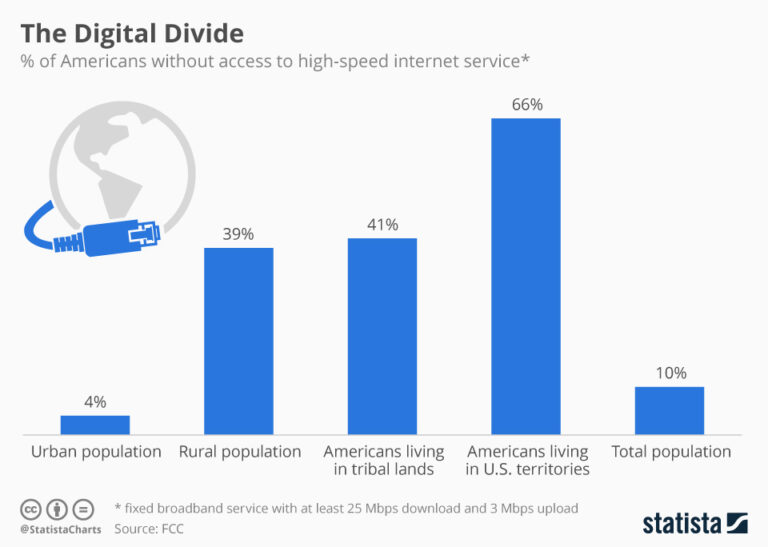Millions of Americans go without access to computers and the internet—especially in rural areas—causing what is known as the “digital divide.” The digital divide often comes up in LEO satellite conversations because this growing technology may be the best way to close the digital divide and create more equitable access to internet worldwide.
What Is the Digital Divide?

The FCC (Federal Communications Commission) reports 22.3% of Americans in rural areas lack access to broadband internet, and in Tribal Lands, the percentage of people without broadband jumps by an additional 5%.
Rural Americans aren’t the only ones who lack internet access—millions of low-income Americans also lack access to broadband internet, either because they cannot afford high rates or because internet providers skip over low-income areas when building infrastructure.
In an era of increasing reliance on the internet—when access to education, jobs, health care, and entertainment are moving online—the disparity in internet access is drawing more attention. Repeatedly, studies show a correlation between internet access and income, innovation, and access to health care. Students with home internet service can do homework assignments and participate in remote learning, while kids without home internet access fall behind
What are the three types of digital divide?
There are three different types of digital divide: access, use, and quality of use.
- Access divide: This is simply the divide between people who have access to the internet and those who don’t. The lack of access can be due to financial reasons, social reasons, lack of infrastructure, or anything else.
- Use divide: The use divide is one of skill—not everyone possesses the technical knowledge to effectively use the internet. Older generations, in particular, may need additional support and training.
- Quality-of-use gap: This divide refers to the user’s ability to get the information they need from the internet, given they have access to it and know how to use it.
Why is the Digital Divide A Problem?
It’s important to reduce the digital divide for a number of reasons. Society has come to rely on technology and especially internet access to function, and not having access to these tools hurts a person’s ability to find work, connect with others, and get the education and training they need to thrive. It’s one of the most important issues facing the world today.
Why is there a lack of internet access in rural areas of the USA?
Telecommunications companies invest heavily in cable and fiber networks in areas where it’s most profitable for them. Wiring a densely packed urban neighborhood for cable costs very little per customer, but running cable lines out to individual farms in Indiana costs a lot per customer. And for similar reasons, internet companies have been more likely to invest in fiber or cable infrastructure in high-income neighborhoods than in low-income areas. This has led to an unequal distribution of internet access based on location, income, and other factors.
One-fourth of Americans living in small towns and rural areas do not have broadband internet access (which is defined by the FCC as an internet connection with at least 25 Mbps download speed). And if they do, it’s from providers who can’t provide enough data to support online schooling or remote work. Building out internet infrastructure to everybody in America could require billions of dollars. But one potential solution to this infrastructure problem is connecting people to the internet from above via low-Earth orbit (LEO) satellites.
Several companies—including SpaceX, Amazon, and others—are building new satellite systems in low-Earth orbit. These companies say that they’ll offer faster speeds and more data to rural customers—all at competitive rates. Can LEO satellite internet really deliver on these promises? The answer isn’t clear yet, but the technology behind LEO is promising.
Although satellites have been orbiting the Earth since the late 1950s, the use of satellites to deliver an internet connection didn’t happen until 2005, when Hughesnet launched the first satellite internet service.
It took 12 years from the time land-based internet service became available to the public (in 1993) for satellite internet service to become a viable internet option. Since then, scientists and engineers have discovered ways to make satellite internet signals faster and more reliable. A key part of this is bringing satellites closer to Earth via low-Earth orbit.
The Lastest Digital divide statistics
- According to the U.S. Government Accountability Office, 18% of people living on tribal lands couldn't access broadband service, versus 4% of people in non-tribal areas. For more on that, check out our guide to Internet Options on Tribal Lands.
- According to the Mckinsey analysis of 2020 U.S. Census Bureau five-year American Community Survey microdata, about 40% of Black American household don’t have high-speed broadband internet, compared to only 28% percent of White American households.
- Latino Decisions’s nationwide poll in mid-2020 revealed “37% of Latino households have either no broadband internet connectivity or connect only through their phone.”
- The International Telecommunications Union found that across the world, 63% of women use the internet compared to 69% of men in 2022. Note that this is a world average, and that digital gender parity percentages can drastically change depending on the country and region you’re looking at.
- The S. Government Accountability Office says that the U.S. Department of Agriculture's ReConnect program has currently awarded more than $1.5 billion to help encourage the expansion of broadband internet in rural areas.
- According to the U.S. Department of Commerce, President Biden’s bipartisan American Jobs Plan contains a $65 billion budget to “expand broadband in communities across the U.S., create more low-cost broadband service options, subsidize the cost of service for low-income households, and provide funding to address the digital equity and inclusion needs in our communities.”

The digital divide in education
Education is one of the places where the digital divide can be most obviously seen, especially since the COVID-19 pandemic started in 2020. The more educators lean into online coursework, textbooks, and online learning in general, those without at-home broadband internet access, computers, smartphones, and tablets grow more and more at a disadvantage.
The introduction of more expensive educational technologies would already be difficult for anyone without access to high-speed internet, but it especially impacts those with major barriers to internet access, like low-income families and those currently homeless.
Education is often seen as, and intended to be, a means of providing equity to people across the board. Education empowers, and the lack of it can put people at a disadvantage, especially if they already come from a historically marginalized community. Perhaps this is why the digital divide concerns educators so deeply, since its impact on students can widen already problematic gaps in opportunity.
Several initiatives have been undertaken to help close this digital divide in public education, including The California Bridging the Digital Divide Fund, which raised $12.3 million to help allocate supplies to students in 2020 and used donations to give students 56,700 laptops and provided 94,000 hot spots.
Where is the digital divide most common?
The digital divide most strongly affects poorer communities across the world, as internet access requires both the funds to purchase technology to use the internet and monthly internet service as well. This can be difficult on an individual level, especially if an individual’s local government also doesn’t have the ability to fund improved access to broadband internet (defined by the Federal Communications Commission as internet speeds of at least 25 Mbps).
You will also find the digital divide more evident when comparing urban and rural areas. Internet service providers (ISPs) consider urban areas are more appealing places to build infrastructure because of the denser population. Internet infrastructure can be expensive to set up and build out, especially for faster internet technologies like fiber, and ISPs want to get the most out of their investment by building in well-populated areas.
This leaves rural areas with fewer internet options, and most often your choices in these areas will be between older technology like DSL internet or slower speeds from rural cable or satellite internet providers.
Is the digital divide getting smaller?
Progress has been made on the digital divide, and it’s encouraging to see the gap close in some areas. For example, in 2017, the ICT Facts and Figures Report found the proportion of women using the internet was 12% lower than the amount of men. But by the end of 2022, the International Telecommunication Union (ITU) found the number shrank to 8%. That 4% difference may not seem like much, but for the people it positively affects, it can mean the world.
Of course, more needs to be done to close the digital divide across different countries and demographics, but this example among others remind us that our hard work can indeed make a difference in empowering one another across the globe.
How can we fix the digital divide?
As with most large-scale problems, the digital divide requires people from all walks of life, industries, and governments to come together to help close it. This means identifying the multiple issues that go into creating the digital divide, like poverty, racism, sexism, ableism, and many other forms of inequity that exacerbate or create the digital divide.
But developments in more accessible internet technologies and intentional government policies are often seen as the most effective ways to help shrink the digital divide. Satellite internet services like Hughesnet, Viasat, and Starlink have been a major part of connecting people in rural areas to opportunities outside their physical sphere, and efforts like the American Jobs Plan offer a way to get underserved communities the resources they need.
The digital divide may never truly close, but the more we work together to help people across the world gain access to internet technologies and empower one another, the narrower the gap will be. That in and of itself is worth working for.